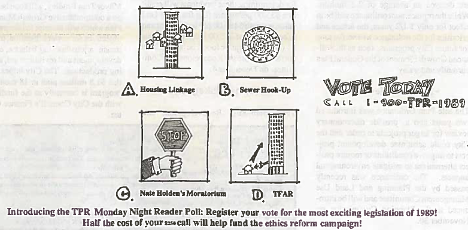1% Arts Development Fee
On December 9, 1988, the City Council adopted an interim ordinance to charge a 1 % fee on all industrial and commercial projects which are valued at over $500,000. If the nexus study is approved, developers will either place the arts fee in a City fund or can carry out art improvements which are credited towards the fee payment. Currently, building permits are now stamped which make owners liable for payment retroactive to January, 1989 based upon the conclusions of the nexus study. The nexus study should be completed by the Spring of 1990.
Sewer Hook Up Ordinance
In April, 1988, the City Council adopted an interim control ordinance to regulate the issuance of sewer hook-up permits. That interim ordinance will expire in February, and the Planning Commission is voting on a replacement ordinance on November 30. The replacement ordinance is not a radical departure from the interim ordinance. Currently, residential projects do not have to wait for sewer hook-up permits, though commercial and industrial projects are delayed an average of 2-3 months. While the replacement ordinance will be in effect for only 1 ½ years, the issues and priorities for the ordinance will set the tone for future City programs, such as the Balanced Growth Element of the General Plan currently underway.
Site Plan Review
The Sile Plan Ordinance was introduced two years ago to provide discretionary review for larger projects in order that the City could scrutinize development projects to improve conditions or require project alternatives to mitigate environmental impacts. The ordinance was recently passed by the Planning and Land Use Management Committee and will be introduced to the Planning Commission on November 30.
As set forth by the ordinance, a conditional use permit is required for commercial projects over 100,000 square feet; site plan review is required for residential projects of at least 35 units and non-residential projects between 40,000 and 100,000 square feet; and discretionary review for commercial and industrial expansions below 40,000 square feet.
Transferable FAR
Whether or not this TFAR issue will be resolved in the near future, the City Council and the CRA are proceeding with 6 projects already in “the pipeline” to determine their public benefit payment on these density transfers. For all other projects, the CRA plans to charge a fee against all new projects in the CBD.
The latest proposal, adopted unanimously by the CRA Board, would impose fees, in addition to the price paid for transferable development rights, of a minimum of $35.00 per square foot of transferred density for a two year period of time. Thereafter, the public benefit payment would be calculated based upon the appraised land value of the transferee site. The calculus for determining these payments will result in a $35.00 per square foot fee if the land value is worth $480.00 per square foot and a fee in excess of $73.00 if the land value is $1,000.00 per square foot. The ordinance is currently before the Redevelopment Committee on December 4.
Housing Linkage Fee
The Community Redevelopment and Housing Committee, chaired by Councilwoman Gloria Molina, is also considering the adoption of a notice ordinance to establish a housing linkage fee for new commercial development. After vigorous lobbying from the development committee and a reconsideration of the ordinance by the Committee's Housing Task Force, the tentative linkage fee is now set at $5.00 per square foot. The most recent changes include exemptions for non-profit developers, projects in enterprise zones, projects which add less than 40,000 square feet, projects in plan check and pre-approved projects. Redevelopment projects are also exempt with the exception of Bunker Hill, Chinatown, the CBD, and Little Tokyo.
Once the notice ordinance is adopted by the City Council, it will take effect 30 days thereafter. A subsequent nexus study will determine the fee level retroactive to 30 days after the notice ordinance is adopted.
Growth Management Plan
The City Planning Department, under the oversite of Councilman Hal Bernson and Mayor Tom Bradley, will soon be working on a comprehensive Growth Management Plan which will attempt to integrate policy objectives for sewer allocation, traffic and transit, a jobs/housing balance, economic development and revitalization, and housing production. The City hopes to finish this $1.8 million plan in 18 months. The program is currently at the funding stage with the City Council's Finance Committee.
- Log in to post comments




